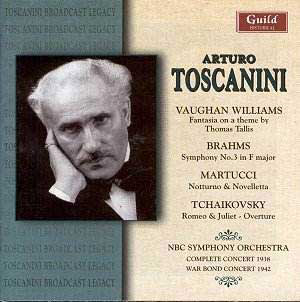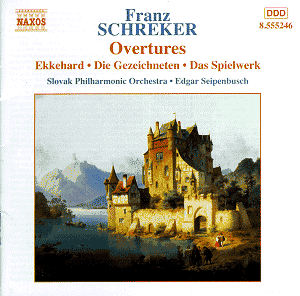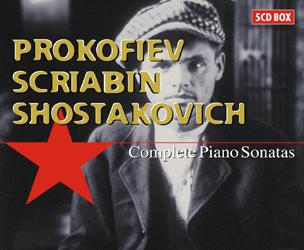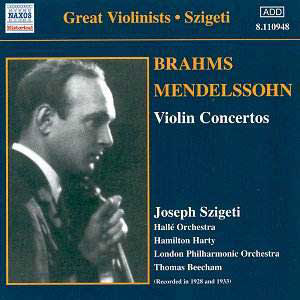 Composer: Arturo Toscanini
Composer: Arturo Toscanini
Works: Vaughan Williams – Fantasia on a Theme by Thomas Tallis; Brahms – Symphony No. 3; Martucci – Notturno and Novelletta; Tchaikovsky – Romeo and Juliet; Bach – Orchestral Suite No. 3 – Air; Haydn – Symphony No. 101 “The Clock”
Performers: NBC Symphony Orchestra/Arturo Toscanini
Recording: 15 October 1938 (Vaughan Williams, Brahms, Martucci, Tchaikovsky) and 4 April 1942 War Bond Concert (Bach, Haydn)
Label: Guild 2211/12 [112’50]
Arturo Toscanini’s legacy as a conductor remains intertwined with the historical fabric of the 20th-century classical music scene, marked by his electrifying interpretations and unwavering commitment to the score. This double set, sourced from the NBC Symphony Orchestra broadcasts, captures Toscanini at a pivotal moment in his career, revealing not only his interpretative prowess but also the evolving soundscape of American orchestral music during a time of both artistic exploration and global turmoil.
The opening performance of Vaughan Williams’ “Fantasia on a Theme by Thomas Tallis” provides an intriguing glimpse into Toscanini’s interpretive choices. The firm, incisive opening pizzicati establish a strong profile, yet the subsequent string surges display an expressive vitality that, while compelling, sometimes sacrifices seamlessness for vigor. This occasionally results in a performance that feels more driven than contemplative, particularly in the notable pause at 9’26, which, while theatrical, risks overshadowing the work’s inherent spirituality. The dynamics at the conclusion seem rehearsed, detracting from the organic flow typically associated with this piece. Despite these reservations, the overall performance remains engaging, characterized by a distinct lack of piety that offers a refreshing perspective, though it may leave purists yearning for more ethereal interpretations.
Turning to Brahms’ Symphony No. 3, Toscanini’s approach is both robust and fluid, imbuing the opening with a sense of elegant momentum that captivates from the outset. The andante unfolds with a dramatic unity that surpasses his later 1952 recording, showcasing a cohesiveness that speaks to the conductor’s interpretative growth. The string playing in the third movement is particularly noteworthy, though some may find Toscanini’s calculated clip to be overly predictable. The finale bursts forth with crisp trumpet fanfares, conveying an animated spirit that is quintessentially Toscaninian.
The inclusion of Martucci’s two orchestrated piano pieces, “Notturno” and “Novelletta,” provides a delightful contrast. “Notturno” emerges as a pastoral gem, lush and inviting, while “Novelletta” reveals Toscanini’s ability to navigate the wittiness inherent in the dotted horn figure, showcasing his skill in extracting character from the score.
Tchaikovsky’s “Romeo and Juliet” opens with an atmospheric introduction that builds palpable anticipation; however, the performance’s incendiary moments, particularly in the Battle music, could be perceived as overly aggressive, challenging traditional notions of scale and proportion. The climactic drum roll and rushed conclusion might leave some listeners questioning the interpretative choices that prioritize dramatic impact over structural coherence.
The 1942 War Bond concert features Bach’s Air and Haydn’s Symphony No. 101, the former presenting a beautifully articulated rendition that exemplifies Toscanini’s ability to distill emotional depth from simplicity. In stark contrast, the Haydn symphony, while executed with characteristic vigor, lacks the nuanced touches that define the composer’s best interpretations. It feels somewhat blunt and overt, missing the delicate interplay and subtlety that can elevate Haydn’s work to its fullest potential.
Sound quality, as expected from Guild, captures the essence of these live performances with an authenticity that allows listeners to appreciate both the orchestral color and the challenges of early broadcast engineering. While some minor imperfections, such as flutter and hum, surface, they do not detract significantly from the overall listening experience.
The recordings presented here, rich in historical context and interpretative fervor, encapsulate a conductor at the height of his powers, yet also reveal the limitations of his artistic choices at times. Toscanini’s legacy, as captured in this collection, serves as both a testament to his indelible impact on the orchestral landscape and an invitation for listeners to reflect upon the complexities of interpretation in classical music.



